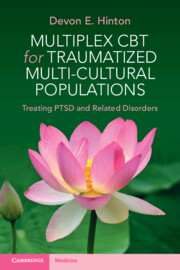Book contents
- Multiplex CBT for Traumatized Multicultural Populations
- Multiplex CBT for Traumatized Multicultural Populations
- Copyright page
- Contents
- Therapist Introduction
- Session 1 Education About Trauma-Related Disorder and the Introduction of Emotion Regulation Techniques
- Session 2 Applied Stretching and the Toe-to-Head Muscle Relaxation with Visualization
- Session 3 Review of the Toe-to-Head Muscle Relaxation with Visualization and the Introduction of the Anxiety Protocol
- Session 4 Education About Trauma and Introduction of the Trauma-Recall Protocol (TRP)
- Session 5 Education About Trauma-Related Disorder, Modification of Catastrophic Cognitions, and Teaching Emotional Distancing
- Session 6 Interoceptive Exposure with Reassociation I: Head Rotation
- Session 7 Interoceptive Exposure with Reassociation II: Hyperventilation
- Session 8 Education About Breathing and Its Use for Relaxation
- Session 9 Sleep Disturbance
- Session 10 Worry and Generalized Anxiety Disorder
- Session 11 Anger and Anger Protocol
- Session 12 Somatic Symptoms I and Review
- Session 13 Somatic Symptoms II and Review
- Session 14 Cultural Syndromes and Final Review
- Book part
- Index
Session 2 - Applied Stretching and the Toe-to-Head Muscle Relaxation with Visualization
Published online by Cambridge University Press: 22 May 2022
- Multiplex CBT for Traumatized Multicultural Populations
- Multiplex CBT for Traumatized Multicultural Populations
- Copyright page
- Contents
- Therapist Introduction
- Session 1 Education About Trauma-Related Disorder and the Introduction of Emotion Regulation Techniques
- Session 2 Applied Stretching and the Toe-to-Head Muscle Relaxation with Visualization
- Session 3 Review of the Toe-to-Head Muscle Relaxation with Visualization and the Introduction of the Anxiety Protocol
- Session 4 Education About Trauma and Introduction of the Trauma-Recall Protocol (TRP)
- Session 5 Education About Trauma-Related Disorder, Modification of Catastrophic Cognitions, and Teaching Emotional Distancing
- Session 6 Interoceptive Exposure with Reassociation I: Head Rotation
- Session 7 Interoceptive Exposure with Reassociation II: Hyperventilation
- Session 8 Education About Breathing and Its Use for Relaxation
- Session 9 Sleep Disturbance
- Session 10 Worry and Generalized Anxiety Disorder
- Session 11 Anger and Anger Protocol
- Session 12 Somatic Symptoms I and Review
- Session 13 Somatic Symptoms II and Review
- Session 14 Cultural Syndromes and Final Review
- Book part
- Index
Summary
Applied muscle relaxation” is traditionally used to describe the relaxation of muscles by contracting a muscle, holding the contraction, and then releasing tension. This might also be called “contract-release muscle relaxation.” Another method of muscle relaxation, such as that used in yoga, involves stretching a muscle by forced elongation and then holding the forced elongation a certain time, then releasing it. This might also be called “elongation-release relaxation” or “stretch-release relaxation.” CA Multiplex CBT teaches both applied muscle relaxation (i.e., “contract-release” relaxation) and applied muscle stretching (i.e., “elongation-release” relaxation), but emphasizes elongation-release relaxation, that is, yoga-type stretching. Traumatized patients have multiple symptoms induced by muscle tension. Examples of sensations caused by muscle tension include joint soreness, muscle soreness, and headache. Additionally, as discussed in the Introduction, applied muscle stretching allows for the introduction of phrases and images that promote a positive self-image of flexibility and prime to being flexible. These are embodied metaphors.
- Type
- Chapter
- Information
- Multiplex CBT for Traumatized Multicultural PopulationsTreating PTSD and Related Disorders, pp. 37 - 44Publisher: Cambridge University PressPrint publication year: 2022



